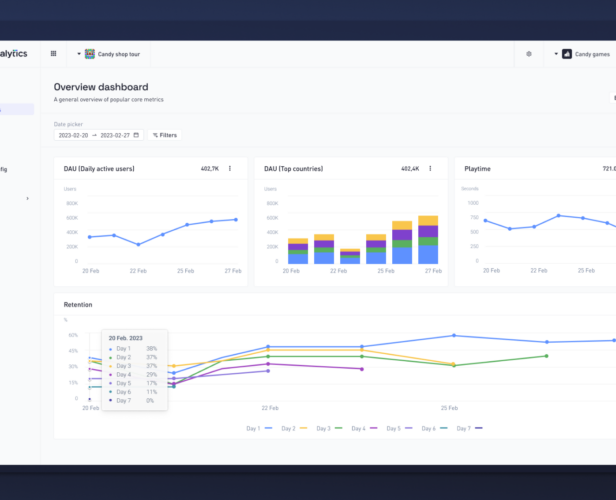Resources > All
Insights and tips about the games industry
Subscribe for gaming insights, industry reports and product updates delivered straight to your inbox.
#Tool & Product
GameAnalytics Secures CIPP Certification
Francesco and the Privacy Team at GameAnalytics play a pivotal role in protecting player information. With a deep understanding of EU law and privacy management, coupled with the CIPP/E certification, they oversee compliance operations for over 100,000 games. This team manages compliance related to standards such as ISO 27001, SOC2 Type II, COPPA, GDPR, ePrivacy Directive, and CCPA. Their dedication ensures game developers using our services are meeting top-tier data privacy and security standards. The role of privacy professionals in today’s digital age can’t be understated. They’re essential in managing privacy threats and ensuring information assets remain secure. The IAPP has set global standards in education and testing for privacy, with the CIPP certification being a prime example. The CIPP/E focuses on European data protection laws, enforcement models, and best practices for data protection. By acquiring this certification, Francesco aligns...
#Game Deconstructions
Behind Lifeline’s Success: An Interview with 3 Minute Games
Lifeline was one of the first mobile games to use push notifications as a core mechanic for their game, which led them to over a million downloads and seven sequels. But what was the secret sauce that led to such success? We spoke with Mars Jokela – Lifeline’s game designer – and Dave Justus – the writer behind the scenes – to ask them what advice they had for other developers and what it was about Lifeline that worked.
#Tool & Product
Seamless Switching: Keep Your Game Insights Engine-Agnostic
The importance of data in game development is undeniable and crucial for optimizing user experience, player retention, monetization, and more. GameAnalytics helps over 60,000 gaming studios optimize and improve their games, offering a well-supported ecosystem of integrations whatever your dev tools of choice. When considering switching engines, the real challenge lies in preserving historically collected data, which serves as a compass guiding future game enhancements and decision-making. We understand these concerns and make sure that you can confidently switch between engines, knowing that your historical data remains intact and actionable.All you need to do is instrument your SDK of choice, and the data collection continues in our engine-agnostic platform, enabling you to make data-driven decisions and continually refine your games. To make it as easy as possible, GameAnalytics is compatible with a wide range of not only engines but also...
#VC & Investments
Infinite worlds: The gaming investment landscape in 2023
The gaming market is a behemoth, with consumers expected to spend $185bn on games this year alone. But how can we expect to see the market evolve? Mattias Ljungman, Founder and Managing Partner of Moonfire, answers just that.
#Game Deconstructions
Exploring Sugartown: Zynga’s NFT-Powered Universe
As Zynga releases their first Web3 game – Sugartown. Rather than in-app purchases or advertising, the game would rely on players buying, trading (and potentially earning) assets. Here's everything we know, and what it means for you.
#Game Design
Kid-Focused Design: The Secret to Engaging 750M Young Gamers
PK XD has over 500 million downloads on Android alone. It gets 30 million views on YouTube every week. And their average session length is 25 minutes a session, with people playing around an hour and a half a day. So what's the secret behind their success? Here's what we know.
#AI
Generative 3D creation with AI prompts
AI is evolving fast. From image generation to artificial assistants, we're seeing more uses for AI hit the market. 3D modeling included. Our friends at Sloyd are launching AI text prompting in their 3D web editor. They've shared all of the details for their latest release.
#Strategies
Adapting to the changing games market: a Zynga spotlight
Every company has its ups and downs. But it’s how they regroup that matters. And Zynga is no different. so we thought we’d dive into what they did and how they came out the other side as one of the most successful mobile gaming companies in the world.
We dive into Zynga’s strategy and how they recovered from losing half their revenue to rise back to $720 million a quarter.
#Tool & Product
GameIntel market insights coming to GameAnalytics!
Following our major V3 update, we're keeping the releases coming. Get ready as GameAnalytics and GameIntel unite, bringing your game's KPIs and wider market insights together in one straightforward view. Better insights are on the horizon!
#AI
Using AI to Supercharge Your Game Art Design
Discover how tweaking AI tool settings can help you generate varied art styles, produce better concepts, and speed up the process from prototype to final design. With AI on your team, creating unique game art has never been easier or faster.
#Data & Analytics
Event Design & Tracking Guide for GameAnalytics
Learn how to create an adaptable tracking plan, enabling you to unlock richer insights and maximize the value of your data within GameAnalytics.
#Ads & Monetization
From Zero to Hero: Tracking Key Success Pillars in Gaming
Our COO, Allison, recently joined Mobvista for the first episode of their "From Zero to Hero" video series. Watch the video today for a detailed overview into tracking three essential pillars of gaming success: Acquisition, Engagement, and Monetization.
#VR & AR
Apple’s Vision Pro: what will it do for the gaming industry?
Apple's new mixed-reality headset, Vision Pro, sets the stage for a revolution in spatial computing, presenting unique opportunities and challenges for developers preparing for a future shaped by immersive technologies.
#Editor's pick
2023 Roblox report: Behind the data with GameAnalytics
Download a comprehensive report of Roblox player behavior and game performance based on GameAnalytics data from 2023. This report highlights critical benchmarks and insights to help Roblox creators optimize their games. What’s inside? Devices analysis Players’ daily session frequency Average revenue spent per user Session length and count benchmarks Retention benchmarks Revenue benchmarks
#Editor's pick
The Game Developer’s Handbook to Mastering Data Solutions
Data is the key to success in the ever-evolving landscape of game development. Explore this guide to transform your data into insights using our turn-key data solutions. What’s inside? Our comprehensive guide explores cost-saving strategies and real-world applications for advanced use cases. Learn how to seamlessly integrate data sources, unlock detailed player insights with Player Warehouse, access real-time data with Raw Export, and ensure data privacy compliance.
#Case study
Developing a #1 VR MMO: Ramen VR’s Journey with GameAnalytics
Discover how Ramen VR used data-driven game development to launch "Zenith: The Last City", which became the #1 bestselling game all major VR platforms—including Meta Quest/Rift, Steam and PlayStation VR.
#Editor's pick
Using AI to Supercharge Your Game Art Design
Discover how tweaking AI tool settings can help you generate varied art styles, produce better concepts, and speed up the process from prototype to final design. With AI on your team, creating unique game art has never been easier or faster.
#Editor's pick
Event Design & Tracking Guide for GameAnalytics
Learn how to create an adaptable tracking plan, enabling you to unlock richer insights and maximize the value of your data within GameAnalytics.
#Editor's pick
From Zero to Hero: Tracking Key Success Pillars in Gaming
Our COO, Allison, recently joined Mobvista for the first episode of their "From Zero to Hero" video series. Watch the video today for a detailed overview into tracking three essential pillars of gaming success: Acquisition, Engagement, and Monetization.
#Editor's pick
How studios use DataSuite to find hit games
Learn how successful publishers evaluate hundreds of games per month, to find the next hit game.
#Editor's pick
Among Us VR dev talks about how to create immersive worlds
VR is all about immersion. It’s about allowing players to lose themselves in more than just a game, but a new world. You have to build VR experiences the right way to make this happen. This goal is always top-of-mind for Schell Games. In this interview, we spoke to Schell Games’ Vice President of Product, Charlie Amis, to learn their story. “For VR, you want to make the player feel like they’re actually in the world you’ve created. This isn’t as true or a high priority in PC and console games. If people start to lose that sense of presence and immersion, then a lot of the reason they put the headset on is hurt. They want to go to another world or be someone new. So you need to help them feel like they’re really there and really that...
#Editor's pick
GameAnalytics H1 Update: New Product Improvements!
It’s been a busy time since February, when the largest update in GameAnalytics history was launched. Read on for more information about what’s changed recently, and new functionality coming to the platform very soon.
#Case study
How TapNation uses DataSuite to increase the LTV of 19 hit games by 50% in only 6 months
Smashing obstacles with Giant Rush While they’ve seen huge improvements using DataSuite across their portfolio, one game stands out in particular: Giant Rush. (And not just because the character is huge.) The title has now reached over 140 million downloads. And, through a series of A/B tests and insights from the data they collected, they’ve been able to increase the LTV by a whopping 200% over six months for this specific title. “It’s because we A/B test every day,” Philippe Grazina from TapNation says. “We ask questions like: When are players leaving the game? For example, the boss in Giant Rush. If we spot that they’re leaving at the same point every time, we know we need to make a change. Small details like that really help.” Through these granular insights, TapNation can iterate and improve on their game step...
#Editor's pick
How to Build a Data Warehouse for Games from Scratch
Over our last couple of blogs around data warehouses, we’ve explained how they let you analyze data from across your portfolio and look at what insights you can gather from them. Now, we’ll dive into how to build a data warehouse. What steps do you need to take and what resources will you need? To figure this out, we’ve rounded up the costs, steps, and tools we think you’ll need to get started. Please note, that we haven’t included the cost of running an engineering department (which you’ll need), which can end up being a lot of $$$. What do I need to get started? Before you start, you’ll need to ensure you have the right people. You’ll likely need a software or data engineer, and perhaps an architect or DevOps engineer. You’ll also need to budget for tools like...






















